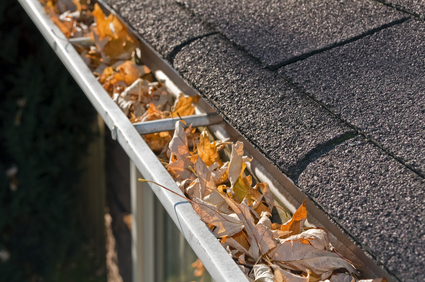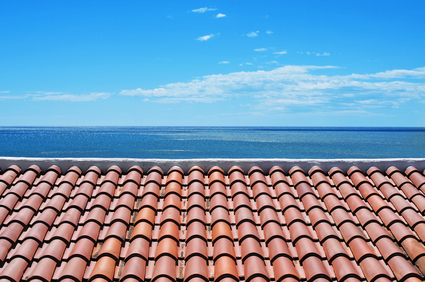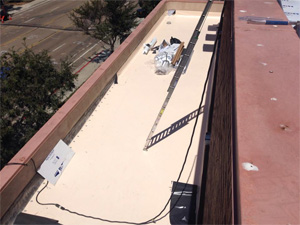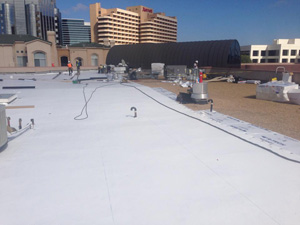The state of your roof can tell you a lot about your home, in general. Water stains may mean that you have backed-up gutters, for instance. And a roof that is waving or denting in places may have storm damage or underlying structural issues. One other thing your roof can tell you about: mold.
Mold under the roof is a less common issue in SoCal than in wetter areas of the country, but that doesn’t mean it never happens. After all, it only takes a little water damage for mold to crop up in otherwise sheltered areas.
So what should you look for to tell if there’s mold happening on or just under your roof? And when should you call an Orange County roofing contractor to take care of the problem? Here’s what you need to know about finding, dealing with, and preventing mold on your roof.
Signs to Look For
First, it’s always important as a homeowner to know what signs to look for as a problem might arise. When it comes to mold in or around your roof, you might notice actual visible stains and streaks that seem to spread on your roof, for instance. If your roof is poorly ventilated, mold can actually grow on top of the roof or just under the shingles, causing discoloration that seems to get worse as time goes by.
It’s more likely, though, that mold signs will be visible inside your home. For instance, you might notice cracked or peeling paint on your ceilings, or even water stains coming through to the ceilings. If you notice signs like these, you either have recent water damage or, potentially, mold.
Also, you should always be on the lookout for worrying physical symptoms in yourself, your children, or your pets. Symptoms of mold reaction can be subtle, and may look like cold, flu, or seasonal allergy symptoms to begin with. But if you notice family members who have increased respiratory issues, itchy skin, runny nose, sneezing, coughing, or sore throat on an ongoing basis, it’s a good idea to look for mold. Other mold exposure symptoms include rashes, headaches, or chest tightness.
If these symptoms are ongoing and out of the ordinary, you’ll want to talk to a doctor, of course. But you may also want to talk to an Orange County roofing contractor who can thoroughly check the top of your home for mold. This is especially true if you notice these symptoms in connection with other physical signs of mold around or outside of your home.
Dealing with Mold on Your Roof
When it comes to dealing with mold on your roof, it’s really best left to the professionals. Mold and mildew growth on the outside of your roof, such as between your tiles, is less likely to cause serious health problems for your family. However, you’ll want to have contractors take care of this unsightly problem before it does further damage to the roofing underlayment.
Usually, contractors will clean the roof thoroughly if exterior mold is the problem. They may use a bleach solution to kill the mold growth, and they may need to replace some of the more affected tiles or shingles, if necessary.
Mold growing under the roof can be a larger problem to deal with, and you may need to talk with a contractor who specializes in mold remediation.
Mold growing in the attic may be harmless cosmetic mold that can be scrubbed off or even left alone. But if the mold variety is potentially hazardous, you’ll have to decide whether to clean it up or actually replace the roofing underlayment.
Replacing underlayment is a costly venture, but could be more efficient than trying to scrub mold off of the wood, treat it, and then keep mold from coming back. Again, though, this is a question for an experienced contractor, and you’ll need to have them come to your home to scope out the problem in order to get a feel for this particular issue.
If you do decide to replace the underlayment, be sure to find out what was likely the cause of the mold growth in the first place. Take steps to prevent such an expensive issue from cropping up again in the future!
Preventing Mold on Your Roof
Preventing mold on and under your roof comes down to two things: design and maintenance.
Design is important because you’ll want to be sure that your attic has enough ventilation. Lack of ventilation traps humid air near the roofing underlayment, which can encourage mold growth. But too much ventilation can also be a bad thing for the health of your home, in general. This is why it’s important to consult with a professional when deciding on the layout of your roof and its ventilation system.
Maintenance is also important. The major cause of mold in and under roofs is leaks, which are often caused by lack of proper maintenance. If your roof isn’t maintained properly, it’s more likely to crack and have leaks, which can, in turn, allow for mold growth.
It’s important to have your roof inspected regularly by an Orange County roofing contractor who can catch small problems before they turn into major issues. During regular inspections, you may find minor issues that the contractors can fix quickly, thus preventing underlayment damage and costly mold problems down the road.
If you have any questions, be sure to reach out to Luke Roofing. A long-established Orange County roofer in Villa Park and surrounding areas, we provide prompt, reliable expertise for every residential roofing need and situation. Wherever and whenever you need roofing services in OC, you definitely can count on Luke Roofing.
 Asphalt shingle roofing is one of the most popular options nationwide, and with good reason. It’s cheap, easy to maintain, and simple to repair. But this doesn’t mean you’ll get good results from your asphalt shingle roof - even the high-end kind with a warranty - by leaving it completely alone.
Asphalt shingle roofing is one of the most popular options nationwide, and with good reason. It’s cheap, easy to maintain, and simple to repair. But this doesn’t mean you’ll get good results from your asphalt shingle roof - even the high-end kind with a warranty - by leaving it completely alone. One of the benefits of installing a tile roof on your home is that they’re virtually maintenance-free. But “virtually” maintenance-free doesn’t mean the same thing as totally maintenance-free. You still need to do some maintenance with your clay tile roof - or hire OC roofing companies to do it.
One of the benefits of installing a tile roof on your home is that they’re virtually maintenance-free. But “virtually” maintenance-free doesn’t mean the same thing as totally maintenance-free. You still need to do some maintenance with your clay tile roof - or hire OC roofing companies to do it. When it comes to your commercial building, the roof is one of the most expensive - and most essential - pieces. A leaky roof can mean serious damage to other systems in your commercial building. This is why it’s essential to hire professionals for commercial roof repair.
When it comes to your commercial building, the roof is one of the most expensive - and most essential - pieces. A leaky roof can mean serious damage to other systems in your commercial building. This is why it’s essential to hire professionals for commercial roof repair. How often should you maintain your commercial roof?
How often should you maintain your commercial roof?